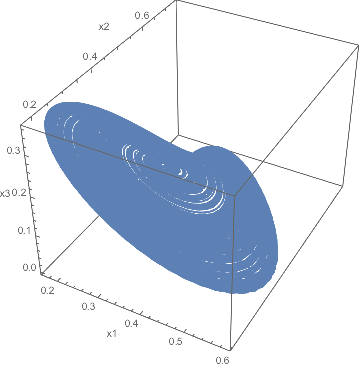Here's how to numerically solve the model.
nsp = 4;
{r[1], r[2], r[3], r[4]} = {1, 0.72, 1.53, 1.27};
{k[1], k[2], k[3], k[4]} = {1, 1, 1, 1};
amat = {{1, 1.09, 1.52, 0}, {0, 1, 0.44, 1.36}, {2.33, 0, 1, 0.47}, {1.21, 0.51, 0.35, 1}};
Do[a[i, j] = amat[[i, j]], {i, nsp}, {j, nsp}];
eqns = Table[x[i]'[t] ==
r[i]*x[i][t]*(1 - Sum[a[i, j]*x[j][t]/k[i], {j, nsp}]), {i, nsp}];
ics = Table[x[i][0] == 0.1, {i, nsp}];
unks = Table[x[i], {i, nsp}];
tmax = 10000;
sol = NDSolve[{eqns, ics}, unks, {t, 0, tmax}][[1]];
ParametricPlot3D[Evaluate[{x[1][t], x[2][t], x[3][t]} /. sol], {t, 100, tmax},
AxesLabel -> {"x1", "x2", "x3"}, PlotPoints -> 200]

I don't know how to color the ParametricPlot3D according to x[4][t] -- that could be an interesting question if it hasn't already been answered on the site.
Update
Here's how to color according to x[4][t], using the slot #4 which represents t here:
ParametricPlot3D[Evaluate[{x[1][t], x[2][t], x[3][t]} /. sol], {t, 100, tmax},
AxesLabel -> {"x1", "x2", "x3"}, PlotPoints -> 400,
ColorFunction -> (ColorData["SunsetColors", x[4][#4] /. sol] &),
ColorFunctionScaling -> False]




